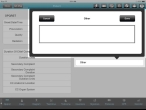Assess OPQRST symptoms
OPQRST is an mnemonic initialism used by medical providers to facilitate taking a patient's symptoms and history in the event of an acute illness. Each letter stands for an important line of questioning for the patient assessment. The parts of the mnemonic are: Onset , Provocation/palliation, Quality, Region/Radiation, Severity, and Time.
-
(If you have not done so already) Add a new incident, or open an existing incident, as described Add or edit an incident.
By default, the Scene tab appears.
-
At the bottom of the screen, touch OPQRST.
Fields for gathering information related to the OPQRST symptoms appear on the left side of the interface.
-
Under OPQRST, enter data as described in Understand the interface and data entry in it.
Field Information needed Onset Date/Time
The date and time when the patient initially experienced the complaint for this call.
Provocation
A description of any movement, pressure (such as palpation) or other external factor makes the problem better or worse. This can also include whether the symptoms relieve with rest.
Quality
The patient's description of the pain (sharp, dull, crushing, burning, tearing, or some other feeling, along with the pattern, such as intermittent, constant, or throbbing).
Radiation
Where the pain is on the body and whether it radiates (extends) or moves to any other area. This can give indications for conditions such as a myocardial infarction, which can radiate through the jaw and arms. Other referred pains can provide clues to underlying medical causes.
Severity
The pain score (usually on a scale of 0 to 10). Zero is no pain and ten is the worst-possible pain.
Duration Of Chief Complaint
The length of time the chief complaint lasted. The chief complaint describes the symptom, problem, or condition that is the reason for a medical encounter.
Duration Units
The units of time the chief complaint is measured in.
Secondary Complaint
A second, less severe problem with the patient, which may or may not be directly related to the chief complaint.
Secondary Complaint Duration
The length of time the chief complain lasted.
Secondary Complaint Duration Units
The units of time the chief complaint is measured in.
CC Anatomic Location
An indication of what portion of the body the chief complaint occurred in.
CC Organ System
An indication of what organ system in the body the chief complaint occurred in.
-
Under Severity and Time, enter data as described in Understand the interface and data entry in it.
Field Information needed Severity
The pain score (usually on a scale of 0 to 10). Zero is no pain and ten is the worst-possible pain.
Days, Hours, Minutes
The number of days, hours, and minutes that have elapsed since the patient began experiencing the complaint for this call.
Other
Any notes about the patient's symptoms and history that may be important to treating the patient.
When you touch this field, a dialog box appears.
- Touch the large blank area in the dialog box, use the iPad keyboard that appears to type notes about the patient's condition, and then touch Done.

